Table of Contents
7.9.2 Tree View
The Tree view consists of a tree, allowing you go to through imported data hierarchy, and options that are designed to rebuild the tree according to the chosen viewing option (see figure below).
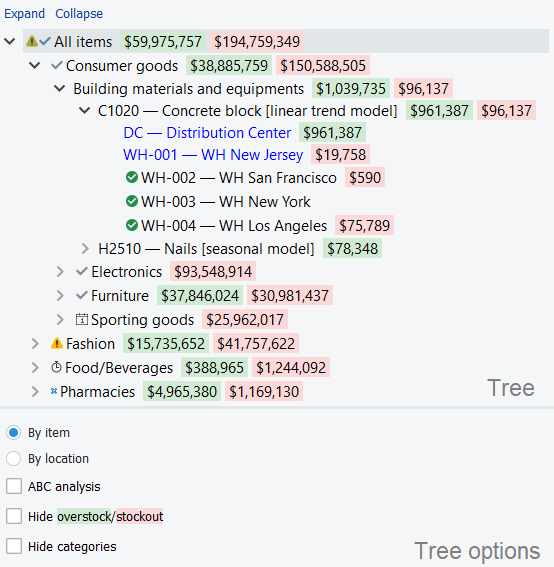
Depending on the imported and configured data, the Tree View shows imported items, locations, channels, and item/location categories. It is used to:
- View your planning items via item, location, and a channel view.
- Identify nodes with particular forecasting/inventory settings using a special icon-coding (see figure above).
- Identify nodes which you have made manual overrides to. Streamline shows them in blue (see figure above). This helps you to spot overridden nodes in the tree.
Information on the selected node immediately appears in the Table, Plot and the Panel.
Buttons
The Collapse and Expand links, residing above the tree, are used to fold and unfold currently selected node.
Money tree
Color-coded numbers in the Tree view show projected stockouts or overstocks in monetary terms. In other words, this feature indicates how much money the company is losing.
Green values show the amount of money that is held in frozen capital due to overstock. It’s calculated by multiplying purchase price and overstock qty.
Red values show the amount of money the company is losing on zero sales due to a lack of inventory. It’s calculated by multiplying sales price and stockout qty.
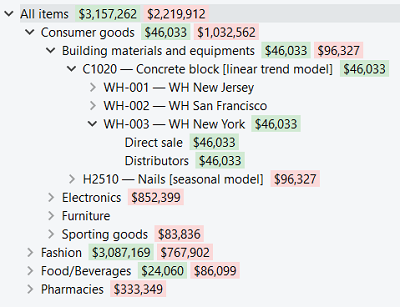
The goal is to reduce these numbers as much as possible by optimizing inventory levels.
Options
Depending on the available data, the set of tree options differs.
- If item/location categories were imported, the Hide categories option is available.
- If locations or channels were imported, there will be two viewing options - By item and By location/By channel.
- If additionally to locations you import channels, Streamline enables you to view your data using six different options.
Here is a list of the available options if locations/channels were imported:
- By item. All the information (forecasts, historical data, inventory) is, first, aggregated by location and location categories, and then, by item and item categories. The tree shows items on top of locations (see figure below).
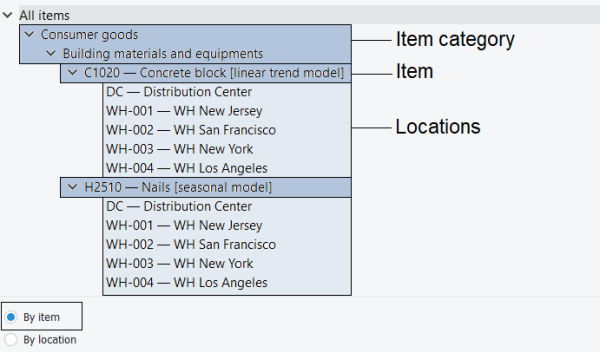
- By location. The information is, first, aggregated by item and item categories, and then, by location and location categories. So, the tree shows locations on top of items (see figure below).
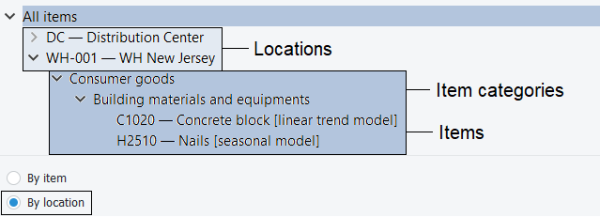
- By channel. The information is, first, aggregated by item and item categories, and then, by channel. The tree shows channels on top of items (see figure below).
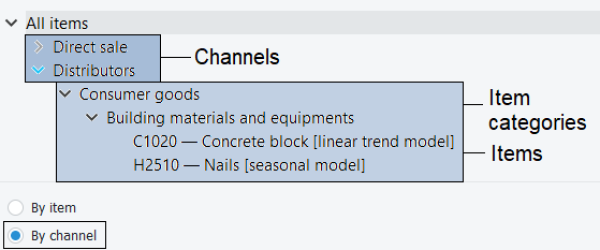
Here is a list of the available options if locations and channels were imported:
- Item — Location — Channel option aggregates your data first by channel, then by location, and then, by item (see figure below).
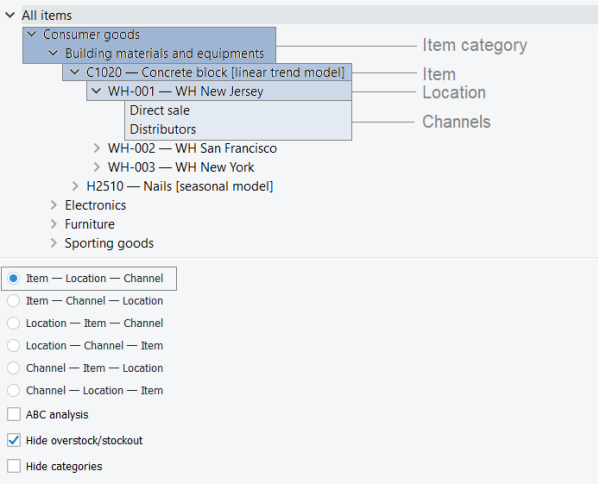
- Item — Channel — Location option aggregates your data by location, channel, and then, by item.
- Location — Item — Channel option groups your data by channel, item, and then, by location.
- Location — Channel — Item option aggregates the data by item, channel, and then, by location.
- Channel — Item — Location option groups your data by location, item, and then, by channel.
- Channel — Location — Item option aggregates the data by item, location, and then, by channel.
Additional options:
- ABC analysis option runs the ABC analysis and categorizes items into three categories: A, B, and C. These categories make up an additional hierarchy to the previous tree and appear on the top of it.
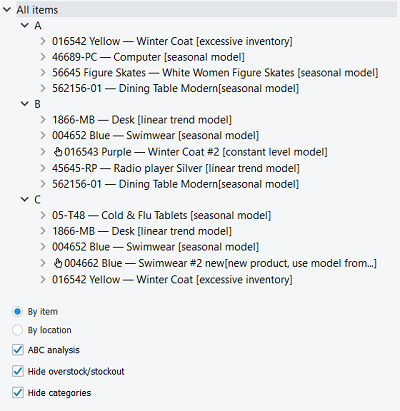
- Hide overstock/stockouts option hides the color-coded money values in the Tree.
- Hide categories option hides item or locations categories in the tree. This is handy, for example, when you need to see the SKUs under the ABC classification directly.
Icon-coding
The Tree view is tightly linked to the Forecasting tab settings. Each option of the tab (except default option) has its own icon that is immediately prefixed to the currently selected tree node. The description of this notation is the following:
 The forecast is approved.
The forecast is approved. The item is checked.
The item is checked. The forecast needs attention and to be reviewed in a future.
The forecast needs attention and to be reviewed in a future. A note is added to the node.
A note is added to the node. The bottom-up forecasting approach is used.
The bottom-up forecasting approach is used. The top-down forecasting approach is used.
The top-down forecasting approach is used. The top-down for child nodes forecasting approach is used.
The top-down for child nodes forecasting approach is used. Zeros in the sales history represent the lost sales.
Zeros in the sales history represent the lost sales. A model multiplier is used.
A model multiplier is used. A custom sales history length is used to generate forecasts.
A custom sales history length is used to generate forecasts. A holidays calendar is used to capture the holidays in the item’s sales history.
A holidays calendar is used to capture the holidays in the item’s sales history. The manufacture procurement changed to purchase.
The manufacture procurement changed to purchase. Ignore actual sales.
Ignore actual sales. Ordering availablility.
Ordering availablility.
Each of the icons has its gray variant meaning that the node inherits the option from its parent.
Context Menu
The context menu of the Tree view holds the most common operations used to manipulate tree nodes. It is accessible with the right mouse button. The commands in the menu are applied to the currently selected node in the Tree view.

- Expand is used to show all sub-levels of the currently selected node.
- Collapse is used to hide all sub-levels of the currently selected node.
- Copy item to clipboard copies the item code of the selected planning item to the clipboard.
- Approve/Unapprove toggles the approval status of the selected node and all its descendants.
- Needs attention is used to indicate that the item needs to be reviewed at a later time.
- Checked applies checked status to the item.
- Find in Inventory report shortcut to find the selected item in the Inventory Tab.
- Find in Reports shortcut to find the selected item in the Report Tabs.
- Remove from import… bans the selected item code (not planning item) from import.
- Substitute merges the selected planning item with the planning item which code is provided in the appeared window on a channel basis (see figure below). If the provided item code exists in the project, this operation removes the item code of the selected planning item from the project, otherwise, it renames it.

Orange in the figure above indicates the channels with merged histories.
- Add note opens the Edit note dialog (see figure below) where you can add, remove, or edit the note for the selected planning item.
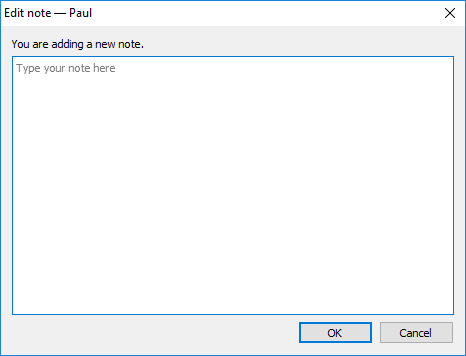
- Clear overrides clears the overrides for the selected planning item made on the Demand forecasting and Inventory planning tabs, except for the overrides to the model coefficients.
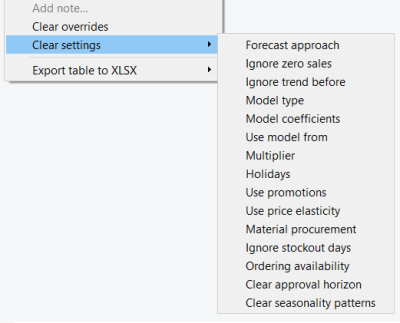
- Export table to XLSX. The Current item command exports the Demand forecasting table of the selected item to Excel. The All child nodes command merges the tables of all the child nodes of the selected item and exports the result in a single Excel spreadsheet.
 A manually
A manually